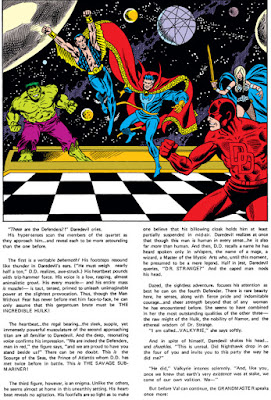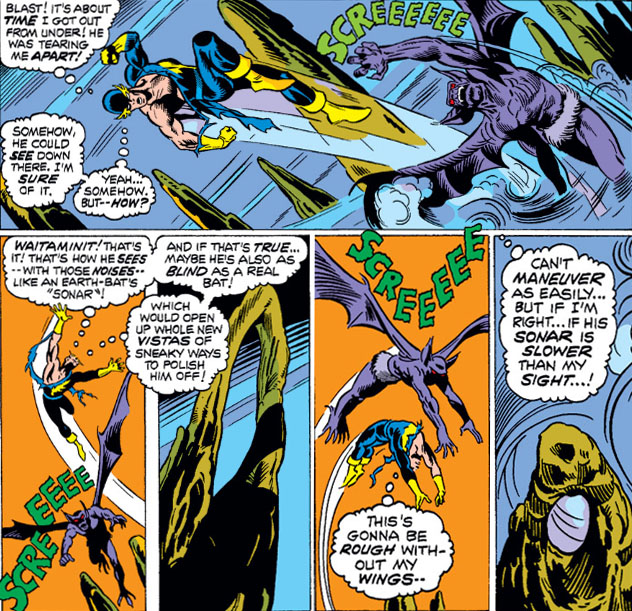Before Marvel's "Giant-Size" line of comics began relying on reprinted material to meet their deadlines, several of the titles in that format produced some noteworthy stories--particularly those featuring the dynamic Defenders, who in 1975 were operating with a core "membership" of Dr. Strange, the Hulk, the Valykrie, and Nighthawk. The Defenders wouldn't have their one and only annual published until over a year later, so a large format book with 40+ pages coming out two or three times a year made for interesting diversions from their monthly title. Despite their unofficial status as a super-team, the Defenders have played in the same arena as the big boys often enough to stand out on the comics racks, taking on mainstream threats like the Squadron Sinister, Magneto, the Wrecking Crew, the Sons of the Serpent, et al. (to say nothing of the Avengers) and keeping them in the comics limelight, if under the radar in terms of their publicity.
So in their third giant-size book, it's something of a masterstroke to see the Defenders deal with the likes of none other than the Grandmaster, whose deadly sense of gamesmanship now reaches out to conscript these individuals and place them on a new level of conflict involving the highest stakes while arguably raising their profile with comics readers. Previously, the Grandmaster played his high-stakes match with Kang the Conqueror, with the Avengers as Kang's champions; but now, in only his second appearance, the Grandmaster returns, once again compelled to compete with another using living chess pieces in combat to determine the winner of the game.
The Grandmaster's opponent this time is the Prime Mover, an artificial construct created by Dr. Doom in order to manipulate agents of S.H.I.E.L.D., making his (its?) second appearance, as well--another nice touch that this issue includes, and a workable opponent for the Grandmaster.
In choosing the Mover, the stakes of the match perhaps lack the drama that Kang's presence and behind-the-scenes activities brought to the table. The Mover, if he wins, is given power to enslave the Earth--while the Grandmaster, should he triumph, simply goes on his way, with no interest in the fate of Earth one way or the other. Both players only have eyes for the game, lacking Kang's passion and simmering rage; it's left to the Defenders, then, to provide the story with action, just as the Avengers did previously.
Once Nighthawk seeks out and secures the aid of Daredevil to make the heroes' roster an even six, play commences--but not before Daredevil and ourselves are introduced to the Defenders, in a stylish segment by writer Steve Gerber and artist Jim Starlin that seems designed to sell a new reader on this group and make a distinctive impression.
There are a lot of hands that went into creating this story, which accounts for the shifting look of the scenes in various places throughout. Gerber, Starlin, and Len Wein plotted the tale, with Gerber scripting; leaving art to no less than four artists, with Starlin on layouts. You'll no doubt see Starlin's influence just about everywhere, even perhaps in the clever use of typewritten narrative that serves not only to give informative descriptions of the Defenders (with Daredevil's hyper-senses supplementing the reader's visual take on the group with deeper impressions), but also the game itself. And as described by the Grandmaster, the terms likely leave the Defenders feeling that this is no game; indeed, it's life and death.
But, what made the Grandmaster seek out the Defenders for this match, you may ask? The answer isn't really crucial to the story, since everyone involved gave their consent to participate when approached by Nighthawk--but the story provides an answer that fits like a glove, as Nighthawk makes clear when he mentions that the Defenders weren't the Grandmaster's first choice.
With six players split into teams of two, we can assume that we'll be seeing three separate segments of battles. It makes perfect sense for the environments, as the Grandmaster states, to be alien for all participants--not just in terms of fairness, but also to add a level of interest for the heroes that removes them from the familiarity the Avengers experienced and has them dealing with more than just the abilities of their foes. Such a scenario is made apparent when Nighthawk and the Valkyrie begin their contest with their opponents who, as the rules have made clear, are out for blood.
The Valkyrie, of course, is no slouch when fighting on horseback with a drawn sword against a like opponent--and, eventually gaining the upper hand, she takes her foe's life with a quick strike that severs his head and sends it plummeting. Or does she? Imagine her surprise when she discovers his decapitation to be only a minor inconvenience for him--yet it gives her insight on discovering the way to victory.
As for Nighthawk, his screeching foe provides for similar deduction:
(Call me crazy, but I don't see how the loss of bulky, artificial "wings" that are only decorative in nature makes Nighthawk less maneuverable.)
That's one round for the Grandmaster, with the Mover understandably confused by the outcome of his meticulous calculations. With the seeming brevity of the battles involving both the Valkyrie and Nighthawk, we might be tempted to think that the entire match is going to play out in such a way; but in Round Two, the level of tension spikes considerably--for despite the alien environment being unfamiliar to all four participants, Daredevil and the Sub-Mariner find that for themselves it may well prove fatal.
Obviously their opponents are able to operate in their surroundings to some extent, while Namor and DD find that the conditions of this world inhibit their ability to resist the attacks being launched against them. Namor would gradually weaken, in any event--but there is an added complication to his current condition that will unfortunately accelerate that process.
Against a foe who doesn't seem to feel Namor's blows in the first place, Namor's likelihood of survival seem nonexistent if he loses what little water retention he has, particularly if he chooses to continue to rely on strength. And speaking of survival, Daredevil has already given us a fair idea of his own chances, with his senses rendered useless by the planet's chaotic, explosive conditions and the shape-shifting nature of his opponent. As a result, his shocking end seems inevitable.
Namor, by now, has his own problems, now barely able to continue against his opponent--but his last stand is as determined and defiant as you would expect. Unfortunately, it leads to a most gruesome end for the Atlantean--and a cold assessment by the orchestrators of this contest.
The fate of the Earth, then--at least in regard to the Prime Mover's plans for it--rests on Round Three and the efforts of Dr. Strange and the Hulk, in an environment that on the bright side is only as hostile as the opponents they face, while its unfamiliarity seemingly springs from the mind of Gerber who attaches to it an obscure description of unknown origin.
(Which is your cue to provide the origin of the so-called "Fred theory"--and no cheating by asking Dr. Strange!)
Despite appearances and the Hulk's mocking disbelief, the diminutive Grott and the Hulk appear to be well-matched--though you wouldn't think so, judging by Grott's casual attitude in facing a man-monster who has a habit of literally crushing his opposition.
Grott, incredibly, goes on to slam and bury the Hulk with half the city's rubble, which certainly gives us an idea of why he's called the Man-Slayer. Meanwhile, Strange also finds himself countered by his own opponent--the evil Korvac, who makes his first appearance in this story and of course would later have designs on reshaping the universe. Now, however, Korvac, thanks to the sadistic treatment of the Badoon, has become the perfect merging of man and computer, a being who battles Strange with computer-quick and perfectly calculated responses to his mystic attacks.
Unfortunately for Korvac, "operator error" applies in his case, since his computer console needs its human operator to invoke its weaponry.
As for Grott's apparent triumph against the Hulk, his conclusion has been a hasty one, since the scope of his attack has left him defenseless against a foe who wasn't yet out for the count.
Korvac and Grott (as well as Daredevil's and Namor's deadly opponents) would go on to be recycled into the 1977 Thor annual (featuring the Guardians of the Galaxy); for now, however, the Prime Mover is forced to do the math on how many rounds he's lost to the Grandmaster. A calculation which leads to a result that it seems even a mechanism can rail against.
The Grandmaster, if you'll recall, has the ability to bestow the power of life or death, so it stands to reason that he's able to restore the lives of those who perished during the game. That's good for Namor and Daredevil, of course; but basking in his victory over the Prime Mover, the Grandmaster informs the Defenders that he's decided to reward himself with the Earth, and use its super-powered beings to breed an entire world of pawns for future games. The Defenders naturally leap to the attack, only to be easily disposed of by the Grandmaster. But one of the group remains--someone who takes a vastly simpler approach in dealing with this cosmic titan.
Fortunately, this time the Grandmaster sticks to the terms of the game and departs in peace. As for Daredevil, the Defenders are more than a little curious as to how he could risk the fate of the Earth on what amounts to the toss of a coin; but without going into detail, he assures them that there was no doubt of the outcome (thanks to his sense of touch which gave him exact knowledge of how the disc was balanced, letting him flip it in such a way that it would land on the side he wished). An old pro like the Grandmaster should really become familiar with the methods of the con artist.
NEXT:
Did someone mention
 | Giant-Size Defenders #3 Script: Steve Gerber Layouts: Jim Starlin Finished Art: Dan Adkins, Don Newton, Jim Mooney Letterer: Charlotte Jetter |




































5 comments:
WOW.., never seen this one.
I was very disappointed with the Heck art on earlier Defenders annuals (even with Yellowjacket on board..). Will have to pick this one up, **love** great Starlin art.
Funny you should mention GSD #4, david_b--keep your eyes peeled, because you'll be getting another look at that issue before you know it!
Ahhh, I forgot GS Defenders 4 with Heck was after ish 3.. my bad. I'm a huge YJ fan.., but 'post-Silver Age Avengers' Donnie Heck just ruins everything for me. Sorry.., I had to give up the '70s TT and Batman Family for a spell because of him. :(
The coin toss actually came up "tails," didn't it?
It certainly looks that way from the artwork, doesn't it, maw maw? We'll just have to assume that with our perspective from a distance we're not able to see the "X" marking on the disc as DD lifted his palm off of it. :D
Post a Comment